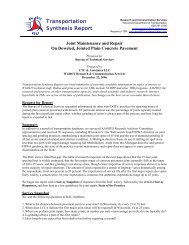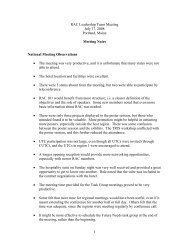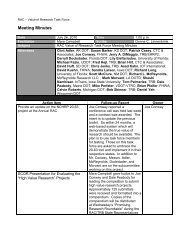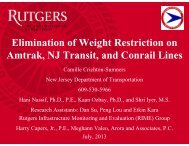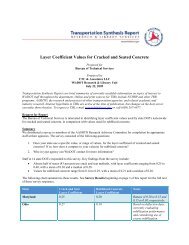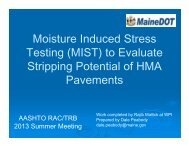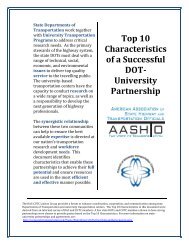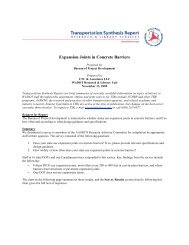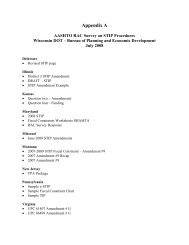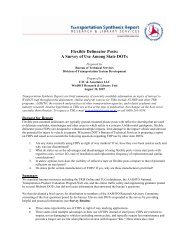PART IV: Summary of Comments - SCOR/RAC
PART IV: Summary of Comments - SCOR/RAC
PART IV: Summary of Comments - SCOR/RAC
Create successful ePaper yourself
Turn your PDF publications into a flip-book with our unique Google optimized e-Paper software.
<strong>PART</strong> <strong>IV</strong>: <strong>Summary</strong> <strong>of</strong> <strong>Comments</strong>17-May-10Reviewer <strong>Comments</strong> Distribution <strong>of</strong> Ratingsnoted in the proposal) warrant evaluation for long-term corrosion damage.■ low need■ [Rating: 3] This is a necessary study because collapse <strong>of</strong> MSE walls due to corrosion can impact the mobility and safety<strong>of</strong> the traveling public. However, the proposed research approach in Task 3 is somewhat weak in that in-situ corrosionpotential and rate measurements may not be feasible due to configuration <strong>of</strong> the two-stage MSE wall.Research Advisory Committee■ 2 Stage MSE walls are not used in a scale that warrants a full blown NCHRP research effort.■ Would make a good pooled fund study.■ While the focus <strong>of</strong> the proposed project is slightly different than the current NCHRP 24-28 project, it is questionablewhether there are enough wall cases out there where corrosion performance data could be obtained. Nevertheless, twostage walls are becoming more commons and an investigation <strong>of</strong> this type <strong>of</strong> wall is warranted.■ MassDOT does not build any <strong>of</strong> these■ Seems under-funded for work described.■ Although we have not experienced corrosion problems with out mse walls, I am aware <strong>of</strong> other DOTs across the countrythat have. The problems that I'm aware <strong>of</strong> are generally at the face/connection. This research is specifically for an msewall type that would appear to have conditions that have a higher potential for corrosion. There is some merit to theproposed research.■ This is not currently a nationwide problemOther■ [Rating: 3] Long term information on these walls is lacking; this study would help.Grossly underfunded for work describedItem #106:D-10Optimizing Flexible Pavement Performance Based onAggregate Physical Properties(17)(46)NR 0 1 2 3 4 5<strong>SCOR</strong> 2 5 4 3 1 2<strong>RAC</strong> 1 5 10 12 11 5 5Standing Committee on Research■ This project will put the findings <strong>of</strong> a previous NCHRP study (4-30) and ongoing (4-34) to fill a critical gap linkingaggregate morphological characteristics to HMA performance. This will enable a more rational use <strong>of</strong> aggregates,increasing the use <strong>of</strong> locally available materials which are important aspects <strong>of</strong> sustainability and energy reduction andcost reduction. The project cost could be reduced or staged to fit into the overall program budget.■ There have been a number <strong>of</strong> studies done in this area.■ There has been extensive work done to related aggregate properties to performance.■ This is a major need. It is important for us to better understand how the interaction between aggregate and the asphalt inHMA ultimately affects the pavement performance.■ [Rating: 4] Enormous strides have been made in characterizing aggregate chemical, physical and morphologicalproperties. However, the weak link in advancing this aggregate research has been the tie in with field performance asnoted in this problem statement. In part this also addresses aggregate sustainability issues.Research Advisory Committee■ Very costly!<strong>IV</strong>-77



